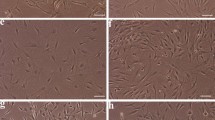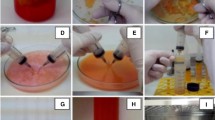Abstract
Growing adipose-derived stem cells (ADSC) in serum-free conditions is important as it represents a way of expanding multipotent cells in a clinical grade medium. Most cultured ADSC are expanded and tested in serum-containing media, which can pose significant health risks if these cells were used in clinical applications. Moreover, cells grown in serum-free conditions behave very different than those cultured in serum-containing media. Here, we present a technique to culture adipose-derived stem cells in serum-free conditions. The methods described in this chapter were optimized for ovine ADSC. The appropriate optimization should be done for other cell lines.
Access this chapter
Tax calculation will be finalised at checkout
Purchases are for personal use only
Similar content being viewed by others
References
Zuk PA, Zhu M, Mizuno H, Huang J, Futrell JW, Katz AJ, Benhaim P, Lorenz HP, Hedrick MH (2001) Multilineage cells from human adipose tissue: implications for cell-based therapies. Tissue Eng 7:211–228. https://doi.org/10.1089/107632701300062859
Pittenger MF, Mackay AM, Beck SC, Jaiswal RK, Douglas R, Mosca JD, Moorman MA, Simonetti DW, Craig S, Marshak DR (1999) Multilineage potential of adult human mesenchymal stem cells. Science 284:143–147. https://doi.org/10.1126/science.284.5411.143
Roberts SJ, Owen HC, Tam WL, Solie L, Van Cromphaut SJ, Van den Berghe G, Luyten FP (2014) Humanized culture of periosteal progenitors in allogeneic serum enhances osteogenic differentiation and in vivo bone formation. Stem Cells Transl Med 3:218–228. https://doi.org/10.5966/sctm.2012-0137
Gronthos S, Mankani M, Brahim J, Robey PG, Shi S (2000) Postnatal human dental pulp stem cells (DPSCs) in vitro and in vivo. Proc Natl Acad Sci U S A 97:13625–13630. https://doi.org/10.1073/pnas.240309797
Seo BM, Miura M, Gronthos S, Bartold PM, Batouli S, Brahim J, Young M, Robey PG, Wang CY, Shi S (2004) Investigation of multipotent postnatal stem cells from human periodontal ligament. Lancet 364:149–155. https://doi.org/10.1016/S0140-6736(04)16627-0
Jin SH, Lee JE, Yun JH, Kim I, Ko Y, Park JB (2015) Isolation and characterization of human mesenchymal stem cells from gingival connective tissue. J Periodontal Res 50:461–467. https://doi.org/10.1111/jre.12228
Raynaud CM, Rafii A (2013) The necessity of a systematic approach for the use of MSCs in the clinical setting. Stem Cells Int 2013:892340. https://doi.org/10.1155/2013/892340
Santos F, Andrade PZ, Abecasis MM, Gimble JM, Chase LG, Campbell AM, Boucher S, Vemuri MC, Silva CL, Cabral JM (2011) Toward a clinical-grade expansion of mesenchymal stem cells from human sources: a microcarrier-based culture system under xeno-free conditions. Tissue Eng Part C Method 17:1201–1210. https://doi.org/10.1089/ten.tec.2011.0255
Wang Y, Han ZB, Song YP, Han ZC (2012) Safety of mesenchymal stem cells for clinical application. Stem Cells Int 2012:652034. https://doi.org/10.1155/2012/652034
Brunner D, Frank J, Appl H, Schoffl H, Pfaller W, Gstraunthaler G (2010) Serum-free cell culture: the serum-free media interactive online database. ALTEX 27:53–62. https://doi.org/10.14573/altex.2010.1.53
Shahdadfar A, Fronsdal K, Haug T, Reinholt FP, Brinchmann JE (2005) In vitro expansion of human mesenchymal stem cells: choice of serum is a determinant of cell proliferation, differentiation, gene expression, and transcriptome stability. Stem Cells 23:1357–1366. https://doi.org/10.1634/stemcells.2005-0094
Pinto DS, Ahsan T, Serra J, Fernandes-Platzgummer A, Cabral JMS, da Silva CL (2020) Modulation of the in vitro angiogenic potential of human mesenchymal stromal cells from different tissue sources. J Cell Physiol 235:7224–7238. https://doi.org/10.1002/jcp.29622
Riis S, Newman R, Ipek H, Andersen JI, Kuninger D, Boucher S, Vemuri MC, Pennisi CP, Zachar V, Fink T (2017) Hypoxia enhances the wound-healing potential of adipose-derived stem cells in a novel human primary keratinocyte-based scratch assay. Int J Mol Med 39:587–594. https://doi.org/10.3892/ijmm.2017.2886
Zanicotti DG, Duncan WJ, Seymour GJ, Coates DE (2018) Effect of Titanium surfaces on the osteogenic differentiation of human adipose-derived stem cells. Int J Oral Maxillofac Implants 33:e77–e87. https://doi.org/10.11607/jomi.5810
Godoy Zanicotti D, Coates DE, Duncan WJ (2017) In vivo bone regeneration on titanium devices using serum-free grown adipose-derived stem cells, in a sheep femur model. Clin Oral Implants Res 28:64–75. https://doi.org/10.1111/clr.12761
Niemeyer P, Fechner K, Milz S, Richter W, Suedkamp NP, Mehlhorn AT, Pearce S, Kasten P (2010) Comparison of mesenchymal stem cells from bone marrow and adipose tissue for bone regeneration in a critical size defect of the sheep tibia and the influence of platelet-rich plasma. Biomaterials 31:3572–3579. https://doi.org/10.1016/j.biomaterials.2010.01.085
Griesche N, Luttmann W, Luttmann A, Stammermann T, Geiger H, Baer PC (2010) A simple modification of the separation method reduces heterogeneity of adipose-derived stem cells. Cells Tissues Organs 192:106–115. https://doi.org/10.1159/000289586
Acknowledgments
The financial support provided by grants from the New Zealand Lottery Board (Lottery Health Research Grant) and the Otago Medical Research Foundation (Jack Thompson Arthritis Grant), and a University of Otago Doctoral Scholarship (awarded to D.G.Z.) are gratefully acknowledged. We also thank the Molecular Biosciences Laboratory (Faculty of Dentistry) personnel.
Author information
Authors and Affiliations
Corresponding author
Editor information
Editors and Affiliations
Rights and permissions
Copyright information
© 2023 The Author(s), under exclusive license to Springer Science+Business Media, LLC, part of Springer Nature
About this protocol
Cite this protocol
Zanicotti, D.G., Milne, T.J., Coates, D.E. (2023). Culturing Adipose-Derived Stem Cells Under Serum-Free Conditions. In: Seymour, G.J., Cullinan, M.P., Heng, N.C., Cooper, P.R. (eds) Oral Biology. Methods in Molecular Biology, vol 2588. Humana, New York, NY. https://doi.org/10.1007/978-1-0716-2780-8_23
Download citation
DOI: https://doi.org/10.1007/978-1-0716-2780-8_23
Published:
Publisher Name: Humana, New York, NY
Print ISBN: 978-1-0716-2779-2
Online ISBN: 978-1-0716-2780-8
eBook Packages: Springer Protocols




